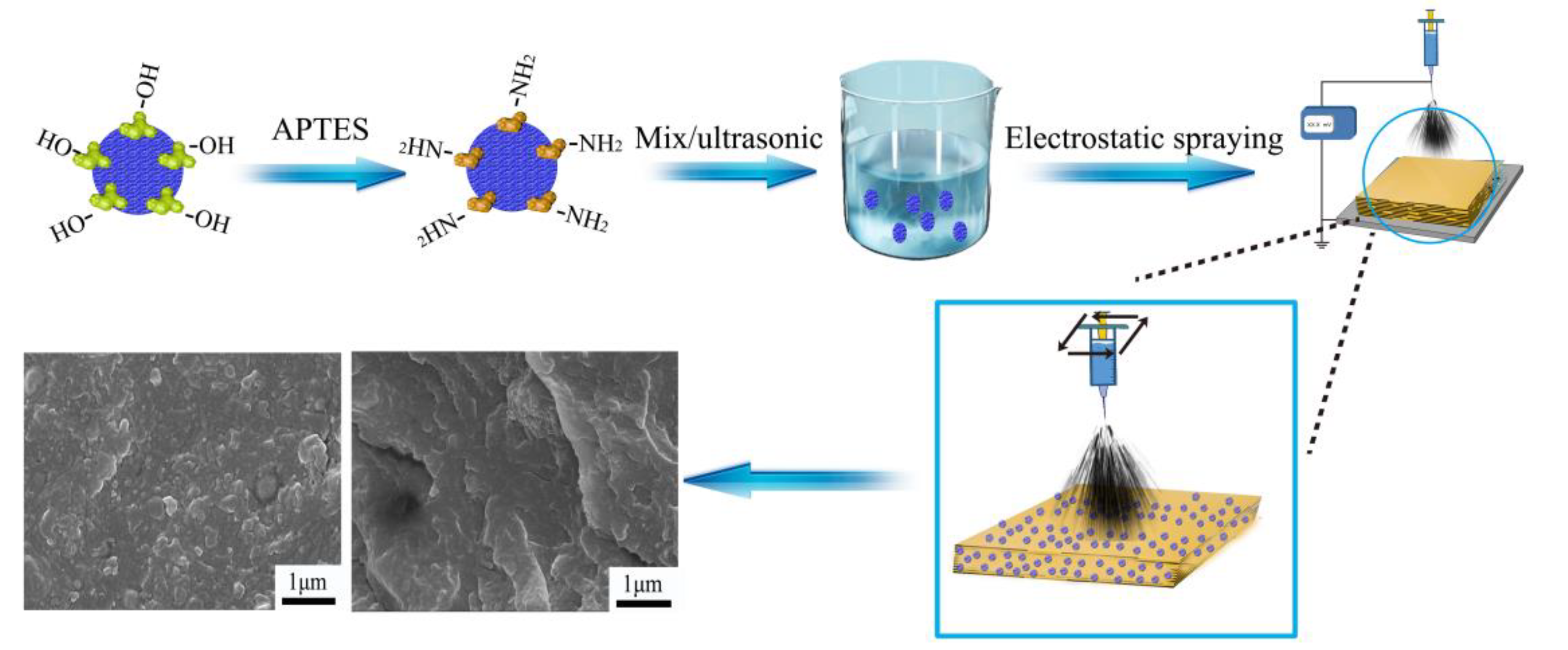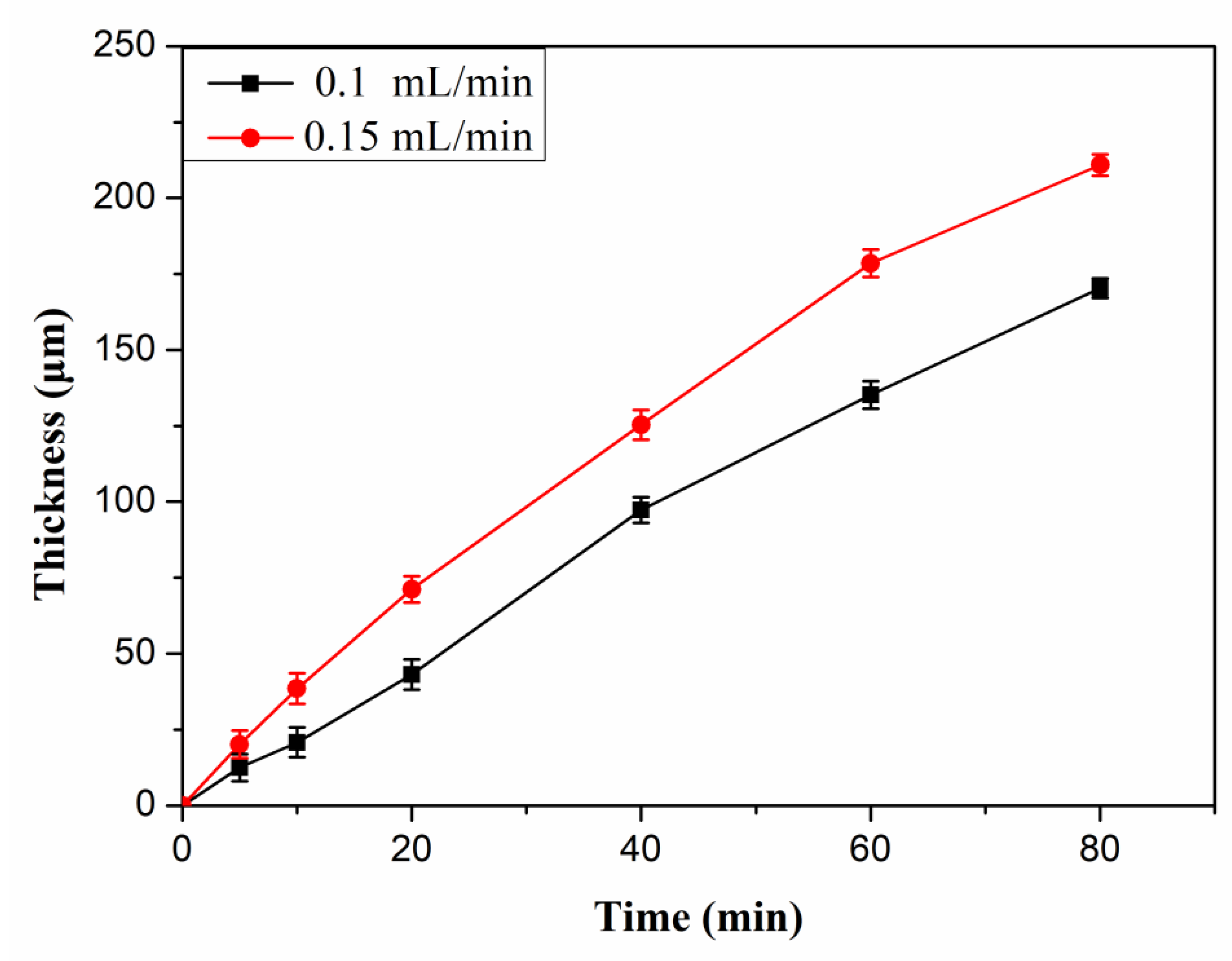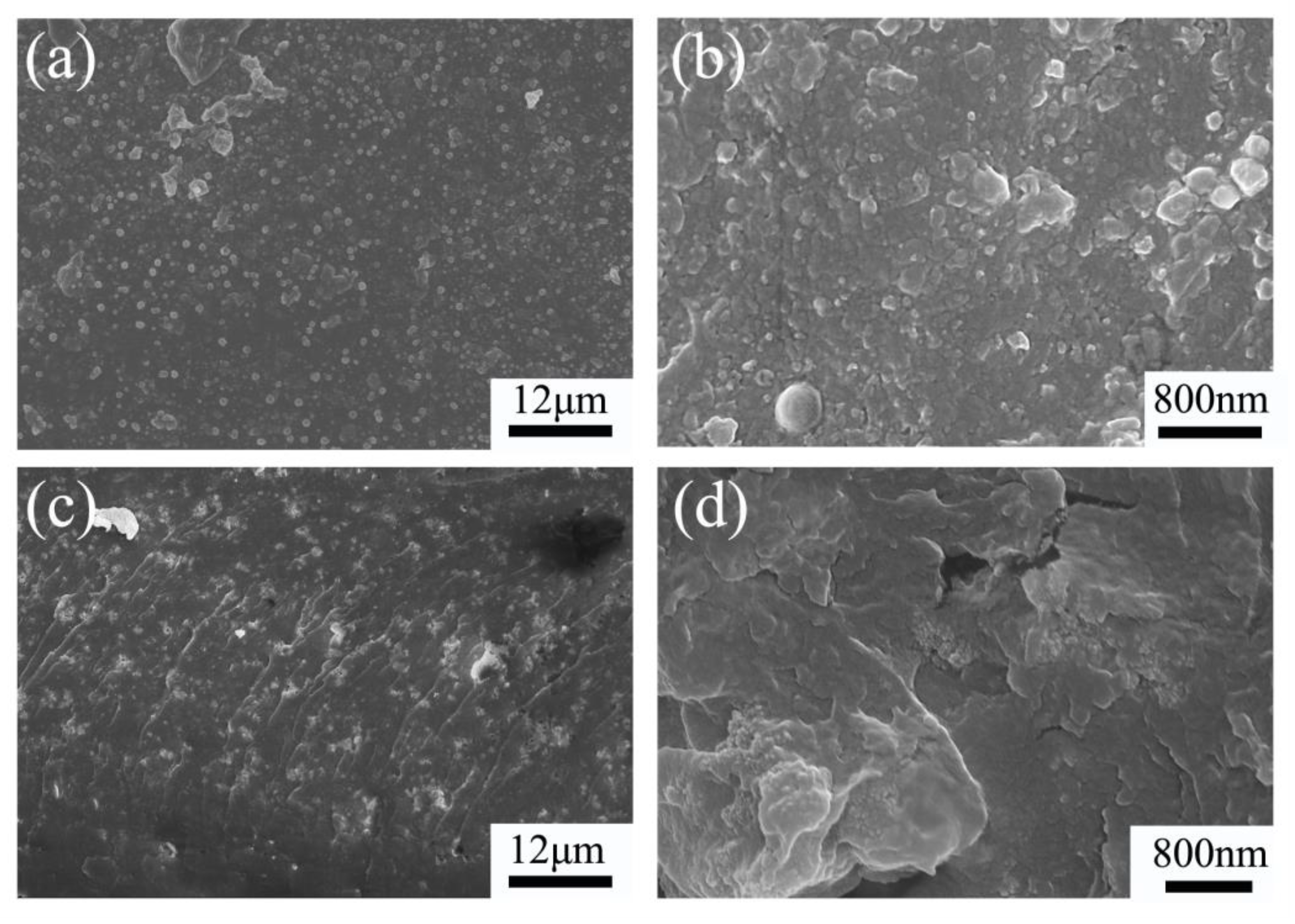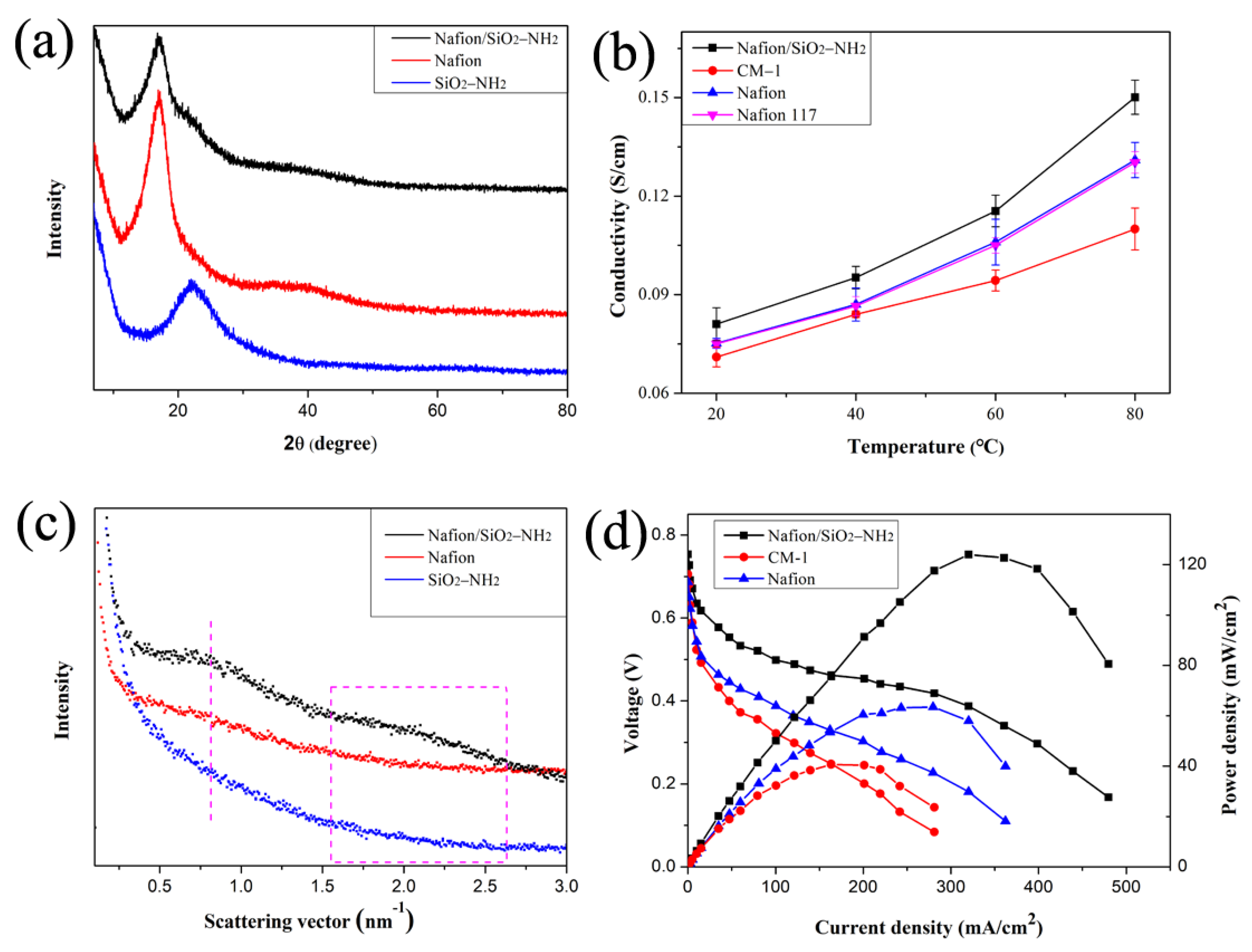Precise Control of the Preparation of Proton Exchange Membranes via Direct Electrostatic Deposition
Abstract
1. Introduction
2. Materials and Methods
2.1. Preparation of the Hybrid Membrane
2.2. Characterization
3. Results and Discussion
3.1. Characterization of SiO2–NH2
3.2. Characterization of Nafion/SiO2–NH2
4. Conclusions
Author Contributions
Funding
Institutional Review Board Statement
Informed Consent Statement
Data Availability Statement
Conflicts of Interest
References
- Elwan, H.; Mamlouk, M.; Scott, K. A review of proton exchange membranes based on protic ionic liquid/polymer blends for polymer electrolyte membrane fuel cells. J. Power Sources 2021, 484, 229197. [Google Scholar] [CrossRef]
- Whiting, K.; Carmona, L.; Sousa, T. A review of the use of exergy to evaluate the sustainability of fossil fuels and non-fuel mineral depletion. Renew. Sustain. Energy Rev. 2017, 76, 202–211. [Google Scholar] [CrossRef]
- Vinothkannan, M.; Kim, A.; Ramakrishnan, S.; Yu, Y.; Yoo, D. Advanced Nafion nanocomposite membrane embedded with unzipped and functionalized graphite nanofibers for high-temperature hydrogen-air fuel cell system: The impact of filler on power density, chemical durability and hydrogen permeability of membrane. Compos. Part B Eng. 2021, 215, 108828. [Google Scholar] [CrossRef]
- Sun, C.; Zhang, H. Review of the Development of First-Generation Redox Flow Batteries: Iron-Chromium System. ChemSusChem 2022, 15, e202101798. [Google Scholar] [CrossRef] [PubMed]
- Wu, J.; Nie, S.; Liu, H.; Gong, C.; Zhang, Q.; Xu, Z.; Liao, G. Design and development of nucleobase modified sulfonated poly(ether ether ketone) membranes for high-performance direct methanol fuel cells. J. Mater. Chem. A 2022. [Google Scholar] [CrossRef]
- Huang, H.; Ma, Y.; Jiang, Z. Spindle-like MOFs-derived porous carbon filled sulfonated poly (ether ether ketone): A high performance proton exchange membrane for direct methanol fuel cells. J. Membr. Sci. 2021, 636, 119585. [Google Scholar] [CrossRef]
- Simari, C.; Nicotera, I.; Aricò, A.S.; Baglio, V.; Lufrano, F. New insights into properties of methanol transport in sulfonated polysulfone composite membranes for direct methanol fuel cells. Polymers 2021, 13, 1386. [Google Scholar] [CrossRef]
- Imaan, D.U.; Mir, F.Q.; Ahmad, B. Synthesis and characterization of a novel poly (vinyl alcohol)-based zinc oxide (PVA-ZnO) composite proton exchange membrane for DMFC. Int. J. Hydrogen Energy 2021, 46, 12230–12241. [Google Scholar] [CrossRef]
- Lu, Y.; Liu, Y.; Li, N.; Hu, Z.; Chen, S. Sulfonated graphitic carbon nitride nanosheets as proton conductor for constructing long-range ionic channels proton exchange membrane. J. Membr. Sci. 2020, 601, 117908. [Google Scholar] [CrossRef]
- Imaan, D.U.; Mir, F.Q.; Ahmad, B. In-situ preparation of PSSA functionalized ZWP/sulfonated PVDF composite electrolyte as proton exchange membrane for DMFC applications. Int. J. Hydrogen Energy 2022, in press. [Google Scholar] [CrossRef]
- Ma, L.; Li, J.; Xiong, J.; Xu, G.; Liu, Z.; Cai, W. Proton conductive channel optimization in methanol resistive hybrid hyperbranched polyamide proton exchange membrane. Polymers 2017, 9, 703. [Google Scholar] [CrossRef] [PubMed]
- Wang, H.; Zhang, J.; Ning, X.; Tian, M.; Long, Y.; Ramakrishna, S. Recent advances in designing and tailoring nanofiber composite electrolyte membranes for high-performance proton exchange membrane fuel cells. Int. J. Hydrogen Energy 2021, 46, 25225–25251. [Google Scholar] [CrossRef]
- Sun, C.; Zhang, H.; Luo, X.; Chen, N. A comparative study of Nafion and sulfonated poly(ether ether ketone) membrane performance for iron-chromium redox flow battery. Ionics 2019, 25, 4219–4229. [Google Scholar] [CrossRef]
- Zhang, J.; Liu, H.; Ma, Y.; Wang, H.; Chen, C.; Yan, G.; Tian, M.; Long, Y.; Ning, X.; Cheng, B. Construction of dual-interface proton channels based on γ-polyglutamic acid@cellulose whisker/PVDF nanofibers for proton exchange membranes. J. Power Sources 2022, 548, 231981. [Google Scholar] [CrossRef]
- Hyun, J.; Doo, G.; Yuk, S.; Yuk, S.; Lee, D.; Lee, D.; Choi, S.; Kwen, J.; Kang, H.; Tenne, R.; et al. Magnetic Field-Induced Through-Plane Alignment of the Proton Highway in a Proton Exchange Membrane. ACS Appl. Energy Mater. 2020, 3, 4619–4628. [Google Scholar] [CrossRef]
- Sun, C.; Negro, E.; Nale, A.; Pagot, G.; Vezzu, K.; Zawodzinski, T.; Meda, L.; Gambaro, C.; Noto, V. An efficient barrier toward vanadium crossover in redox flow batteries: The bilayer [Nafion/(WO3)x] hybrid inorganic-organic membrane. Electrochim. Acta 2021, 378, 138133. [Google Scholar] [CrossRef]
- Zhang, X.; Yu, S.; Zhu, Q.; Zhao, L. Enhanced anhydrous proton conductivity of SPEEK/IL composite membrane embedded with amino functionalized mesoporous silica. Int. J. Hydrogen Energy 2019, 44, 6148–6159. [Google Scholar] [CrossRef]
- Ahmadian-Alam, L.; Mahdavi, H. A novel polysulfone-based ternary nanocomposite membrane consisting of metal-organic framework and silica nanoparticles: As proton exchange membrane for polymer electrolyte fuel cells. Renew. Energy 2018, 126, 630–639. [Google Scholar] [CrossRef]
- Pal, S.; Mondal, R.; Chatterjee, U. Sulfonated polyvinylidene fluoride and functional copolymer based blend proton exchange membrane for fuel cell application and studies on methanol crossover. Renew. Energy 2021, 170, 974–984. [Google Scholar] [CrossRef]
- Patnaik, P.; Mondal, R.; Sarkar, S.; Choudhury, A.; Chatterjee, U. Proton exchange membrane from the blend of poly(vinylidene fluoride) and functional copolymer: Preparation, proton conductivity, methanol permeability, and stability. Int. J. Hydrogen Energy 2022, in press. [Google Scholar] [CrossRef]
- Ma, L.; Xu, G.; Li, S.; Ma, J.; Li, J.; Cai, W. Design and optimization of a hyper-branched polyimide proton exchange membrane with ultra-high methanol-permeation resistivity for direct methanol fuel cells applications. Polymers 2018, 10, 1175. [Google Scholar] [CrossRef] [PubMed]
- Sun, L.; Gu, Q.; Wang, H.; Yu, J.; Zhou, X. Anhydrous proton conductivity of electrospun phosphoric acid-doped PVP-PVDF nanofibers and composite membranes containing MOF fillers. RSC Adv. 2021, 11, 29527–29536. [Google Scholar] [CrossRef]
- Wang, H.; Tang, C.; Zhuang, X.; Cheng, B.; Wang, W.; Kang, W.; Li, H. Novel structure design of composite proton exchange membranes with continuous and through-membrane proton-conducting channels. J. Power Sources 2017, 365, 92–97. [Google Scholar] [CrossRef]
- Sood, R.; Giancola, S.; Donnadio, A.; Zatoń, M.; Donzel, N.; Rozière, J.; Jones, D.J.; Cavaliere, S. Active electrospun nanofibers as an effective reinforcement for highly conducting and durable proton exchange membranes. J. Membr. Sci. 2021, 622, 119037. [Google Scholar] [CrossRef]
- Cheng, G.; Li, Z.; Ren, S.; Han, D.; Xiao, M.; Wang, S.; Meng, Y. A robust composite proton exchange membrane of sulfonated poly (fluorenyl ether ketone) with an electrospun polyimide mat for direct methanol fuel cells application. Polymers 2021, 13, 523. [Google Scholar] [CrossRef]
- Li, H.; Lee, Y.; Lai, J.; Liu, Y. Composite membranes of Nafion and poly(styrene sulfonic acid)-grafted poly(vinylidene fluoride) electrospun nanofiber mats for fuel cells. J. Membr. Sci. 2014, 466, 238–245. [Google Scholar] [CrossRef]
- Liu, G.; Tsen, W.; Wen, S. Sulfonated silica coated polyvinylidene fluoride electrospun nanofiberbasedcomposite membranes for direct methanol fuel cells. Mater. Des. 2020, 193, 108806. [Google Scholar] [CrossRef]
- Ballengee, J.B.; Pintauro, P.N. Preparation of nanofiber composite proton-exchange membranes from dual fiber electrospun mats. J. Membr. Sci. 2013, 442, 187–195. [Google Scholar] [CrossRef]
- Zhao, G.; Xu, X.; Zhao, H.; Shi, L.; Zhuang, X.; Cheng, B.; Yin, Y. Zeolitic imidazolate framework decorated on 3D nanofiber network towards superior proton conduction for proton exchange membrane. J. Membr. Sci. 2020, 601, 117914. [Google Scholar] [CrossRef]
- Klingele, M.; Breitwieser, M.; Zengerle, R.; Thiele, S. Direct deposition of proton exchange membranesenabling high performance hydrogen fuel cells. J. Mater. Chem. A 2015, 3, 11239–11245. [Google Scholar] [CrossRef]
- Breitwieser, M.; Klose, C.; Klingele, M.; Hartmann, A.; Erben, J.; Cho, H.; Kerres, J.; Zengerle, R.; Thiele, S. Simple fabrication of 12 μm thin nanocomposite fuel cell membranes by direct electrospinning and printing. J. Power Sources 2017, 337, 137–144. [Google Scholar] [CrossRef]
- Wang, H.; Li, X.; Feng, X.; Liu, Y.; Kang, W.; Xu, X.; Zhuang, X.; Cheng, B. Novel proton-conductive nanochannel membranes with modified SiO2 nanospheres for direct methanol fuel cells. J. Membr. Sci. 2018, 22, 3475–3484. [Google Scholar] [CrossRef]
- Wang, H.; Sun, N.; Zhang, L.; Zhou, R.; Ning, X.; Zhuang, X.; Long, Y.; Cheng, B. Ordered proton channels constructed from deoxyribonucleic acid-functionalized graphene oxide for proton exchange membranes via electrostatic layer-by-layer deposition. Int. J. Hydrogen Energy 2020, 45, 27772–27778. [Google Scholar] [CrossRef]
- Zhang, S.; He, G.; Gong, X.; Zhu, X.; Wu, X.; Sun, X.; Zhao, X.; Li, H. Electrospun nanofiber enhanced sulfonated poly (phthalazinone ether sulfone ketone) composite proton exchange membranes. J. Membr. Sci. 2015, 493, 58–65. [Google Scholar] [CrossRef]
- Dong, C.; Hao, Z.; Wang, Q.; Zhu, B.; Cong, C.; Meng, X.; Zhou, Q. Facile synthesis of metal oxide nanofibers and construction of continuous proton-conducting pathways in SPEEK composite membranes. Int. J. Hydrogen Energy 2017, 42, 25388–25400. [Google Scholar] [CrossRef]
- Bisht, S.; Balaguru, S.; Ramachandran, S.K.; Gangasalam, A.; Kweon, J. Proton exchange composite membranes comprising SiO2, sulfonated SiO2, and metal–organic frameworks loaded in SPEEK polymer for fuel cell applications. J. Appl. Polym. Sci. 2021, 138, 50530. [Google Scholar] [CrossRef]
- Wang, H.; Wang, X.; Fan, T.; Zhou, R.; Li, J.; Long, Y.; Zhuang, X.; Cheng, B. Fabrication of electrospun sulfonated poly(ether sulfone) nanofibers with amino modified SiO2 nanosphere for optimization of nanochannels in proton exchange membrane. Solid State Ion. 2020, 349, 115300. [Google Scholar] [CrossRef]





| Samples | Methanol Permeability (10−7 cm2 s−1) |
|---|---|
| Nafion | 17.5 |
| Nafion/SiO2–NH2 | 9.8 |
| CM-1 | 9.1 |
| PEMs | Proton Conductivity (S/cm) | Power Density (mW/cm2) | Ref. |
|---|---|---|---|
| PSU/mMOF/Si-SO3H | 0.017 (70 °C, 100% RH) | 40.8 (70 °C) | [18] |
| SPEEK/TiNFs-1.0 | 0.037 (80 °C, 100% RH) | 431.5 (60 °C) | [35] |
| SPEEK/S-SiO2/MOF-5 | 0.00369 (30 °C, 100% RH) | NA | [36] |
| Nafion/SPES/SiO2–3% | 0.23 (80 °C, 100% RH) | 77.22 (80 °C) | [37] |
| Nafion/SiO2–NH2 | 0.15 (80 °C, 100% RH) | 124.01 (40 °C) | This work |
Publisher’s Note: MDPI stays neutral with regard to jurisdictional claims in published maps and institutional affiliations. |
© 2022 by the authors. Licensee MDPI, Basel, Switzerland. This article is an open access article distributed under the terms and conditions of the Creative Commons Attribution (CC BY) license (https://creativecommons.org/licenses/by/4.0/).
Share and Cite
Liu, H.; Tian, R.; Liu, C.; Zhang, J.; Tian, M.; Ning, X.; Hu, X.; Wang, H. Precise Control of the Preparation of Proton Exchange Membranes via Direct Electrostatic Deposition. Polymers 2022, 14, 3975. https://doi.org/10.3390/polym14193975
Liu H, Tian R, Liu C, Zhang J, Tian M, Ning X, Hu X, Wang H. Precise Control of the Preparation of Proton Exchange Membranes via Direct Electrostatic Deposition. Polymers. 2022; 14(19):3975. https://doi.org/10.3390/polym14193975
Chicago/Turabian StyleLiu, Hao, Runmin Tian, Chunxu Liu, Jinghan Zhang, Mingwei Tian, Xin Ning, Xingyou Hu, and Hang Wang. 2022. "Precise Control of the Preparation of Proton Exchange Membranes via Direct Electrostatic Deposition" Polymers 14, no. 19: 3975. https://doi.org/10.3390/polym14193975
APA StyleLiu, H., Tian, R., Liu, C., Zhang, J., Tian, M., Ning, X., Hu, X., & Wang, H. (2022). Precise Control of the Preparation of Proton Exchange Membranes via Direct Electrostatic Deposition. Polymers, 14(19), 3975. https://doi.org/10.3390/polym14193975









